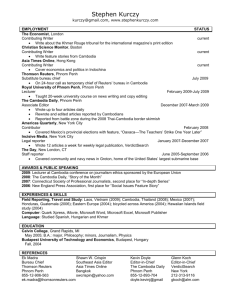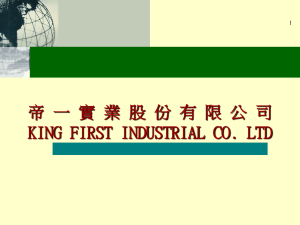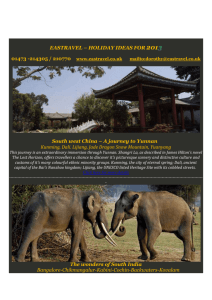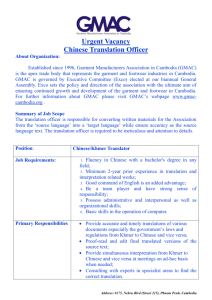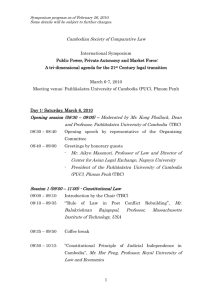Document
advertisement
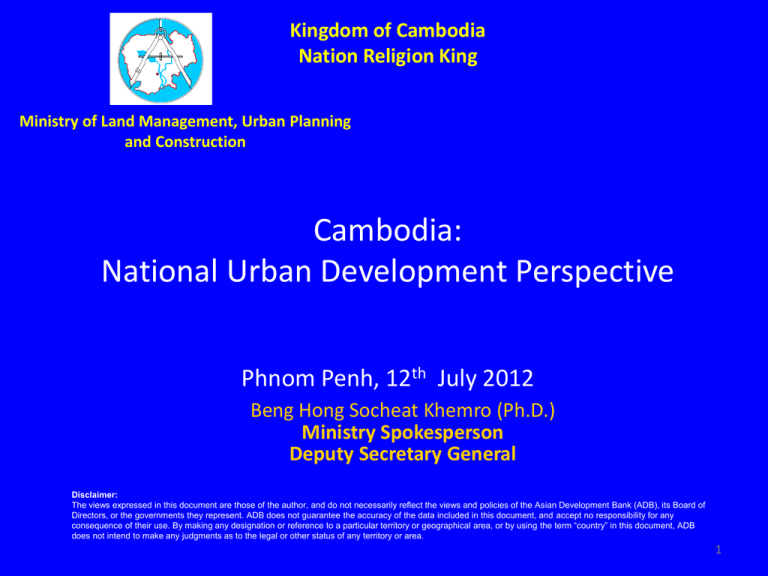
Kingdom of Cambodia Nation Religion King Ministry of Land Management, Urban Planning and Construction Cambodia: National Urban Development Perspective Phnom Penh, 12th July 2012 Beng Hong Socheat Khemro (Ph.D.) Ministry Spokesperson Deputy Secretary General Disclaimer: The views expressed in this document are those of the author, and do not necessarily reflect the views and policies of the Asian Development Bank (ADB), its Board of Directors, or the governments they represent. ADB does not guarantee the accuracy of the data included in this document, and accept no responsibility for any consequence of their use. By making any designation or reference to a particular territory or geographical area, or by using the term “country” in this document, ADB does not intend to make any judgments as to the legal or other status of any territory or area. 1 Content: • Country’s profile and urbanisation trend • Existing Country’s urban Strategy, priority, milestone for urban development • Institutional urban structure • Approach, policy and incentives for urban investment • Development partner in urban sector 2 Cambodia’s Profile Population: 14.8 millions Land Area: 181, 035 km2 Density: 81.8 person/km2 Capital: Phnom Penh (1.4 millions) Number of labour force: 7,035,398 (53%) (Female : 3,608,345) 3 Key Urbanisation trends: As shown in the Graph, urbanisation in Cambodia is on the increase after the Khmer Rouge regime which provide opportunities for investors not only in the capital city but many other emerging cities and towns with diverse business possibilities Phnom Penh capital city Other cities and towns Before the fall of the Khmer Republic to the Khmer Rouge 2.5 Millions 2 Millions 1 Million Civil wars Khmer Rouge Repatriation Peace time Peace time 1960 1970 1973 1975 1979 1993 2012 4 Urbanisation Trends • Urban Population Growth: 1.54 % • Fast growing cities and towns: – Capital city of Phnom Penh (2.8 percent annual population growth), – Economic pole cities of Siem Reap and Sihanoukvilleial – Provincial and district agricultural potential capital cities and towns, Battambang, Sisophon, Kampot, Kampung Speu, Soung, Snoul, Kratie, Kampungcham, Svay Rieng, – Provincial and district tourism potential capital cities and towns Steung Treng, Mundulkiri, Ratanakiri, Kep, Koh Kong, – Cross border cities and towns, Poi Pet, Barvet, Koh Kong, Samrong, 5 Existing Country’s urban Strategy, priority, milestone for urban development 6 Through road infrastructure improvement to the capital city and other important key economic poles, the Royal Government hopes to maximise the benefits from the economic poles to other provincial cities and town with proper planning Stung Treng Siem Reap The planning also aim to decentralise development from the capital city to other secondary cities and towns Battambang Kompong Cham Phnom Penh NationalNetwork Network Frame National Frame Backbone Backbone Multi growth pole Multi growth pole Sihaknoukville Isolated provincial Isolated provincial capital capital 7 The Royal Government has invested heavily on infrastructure in order Promotion of national integration Siem Reap Stung Treng Battambang Kompong Cham Phnom Penh National Network Frame Backbone National integration Multi growth pole Sihaknoukville Isolated provincial capital In order to reduce poverty in rural areas throughout the country The Royal Government has invest in building and upgrading road infrastructure connecting urban centres and rural areas as to create more opportunities for rural population through rural-urban linkages and provide them with markets for rural 8 produces. Institutional Urban Structure: Spatial Planning Procedure 9 Figure 1-4 Involvement of Stakeholder in Provincial Spatial Planning Institutional Urban Structure: Spatial Planning Procedure In order to achieve sustainable and environmental friendly development, the Royal Government of Cambodia will embark on the following physical planning: • National Spatial Plan • Regional Spatial Plan – Inter-countries regional plan, Cambodia-Laos-Vietnam, Greater Mekong Sub-Region – In-country regional plan, Coastal Area plan, Northeastern region plan • Provincial and Municipal Plan (Master Plan) • District and Khan Plan (District Strategic Development Plan) • Communal Plan (Commune Land Use Plan) • Village Plan (Participatory Land Use Plan), All of which attempt to achieve first, proper utilisation of resources, second, sharing benefits from resource utilisation to investors and the public and third, contribute to land market stabilisation and fourth, sustain social and economic development. 10 Institutional Urban Structure: Hierarchical order of spatial planning in Cambodia • 11 Hierarchical order of spatial planning in Cambodia Short-term operational and detail land use plan Regional Provincial The Royal Government has recently established hierarchical mechanisms for overseeing these spatial planning at all level, the National Committee for Land Management and Urban Planning, at all level District Commune Bottom Up Approach Medium-term development plan National Top Down Approach Long-term strategic plan (Development Policy Guideline) Village 12 Hierarchical order of spatial planning in Cambodia In order to achieve sustainable and environmental friendly development, the Royal Government of Cambodia will embark on the following physical planning: • National Spatial Plan • Regional Spatial Plan – Inter-countries regional plan, Cambodia-Laos-Vietnam, Greater Mekong Sub-Region – In-country regional plan, Coastal Area plan, Northeastern region plan • Provincial and Municipal Plan (Master Plan) • District and Khan Plan (District Strategic Development Plan) • Communal Plan (Commune Land Use Plan) • Village Plan (Participatory Land Use Plan), All of which attempt to achieve first, proper utilisation of resources, second, sharing benefits from resource utilisation to investors and the public and third, contribute to land market stabilisation and fourth, sustain social and economic development. 13 Policy on urban investment 14 Policy & Legal Framework for sustainable urban development • Policy: – – – – – – – The Royal Government’s Declaration on Land Policy Interim Paper on Strategic Framework on Land Policy National Spatial Policy Law on Land Management, Urbanisation and Construction Policy on Social Land Concession Policy on State Land Management Land Valuation Policy • Legal framework: – Law on Territorial and Land Management – Sub-Decree 86 on Building Permission – Land Registration – Circular 03 on Squatter Settlement Resolution As well as many others are in the process of formulation. 15 Development Partner in urban sector Most Development Partners have so far targeted rural development and other sectors as their priorities for poverty alleviation in Cambodia , thus urban sector has been rather left out. There have been of course some technical assistance mostly in the forms of research and basic or trial physical planning assisted by the German GTZ and now GIZ and EU in Western region province of Battambang and Siem Reap and the assistance from the French Government on Phnom Penh city master plan as well as JICA on the city’s infrastructure and services such as drainage and public transport. Other IOs have also have projects and programmes on urban related issues such as housing the urban poor in Phnom Penh by UNHABITAT . 16 Urban planning for growth: National Urban Development Strategy Kingdom of Cambodia Laos Thailand Vietnam Gulf of Thailand Vietnam THANK YOU for Your Kind Attention 19
